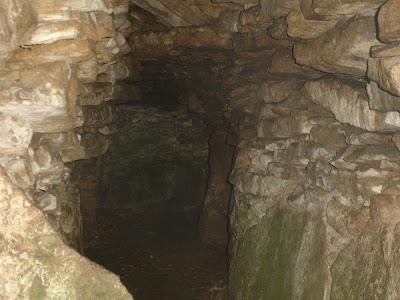I parked at the top of the lane by the farm buildings, you can drive all the way down for about a mile and park by the Wellow Brook for the longbarrow, but today decided to walk the lane.
Moss already anticipating a decent walk, is off and out of the car and we make our way down the narrow lane. There are not many flowers at this time of the year, the first flush being over, but the air is warm and there are butterflies around on the blackberry bushes. The elderberries are already turning dark red and the lane disappears into a tunnel of trees creating a cool atmosphere. The Wellow Brook burbles contentedly to the left, snaking its way through the fields, and I take a photo of the Barrow crouched on the far hillside. Stoney Littleton sits under the ridge, its entrance facing upwards, maybe to greet sunrise, there is a ceremony around the 23rd December, when the sun is said to strike the back of the chambers.
At last we arrive at the small stile and bridge that crosses the brook, here one must stand and take in the azure blue of the demoiselles as they swoop across the water landing on pretty pink flowers to show off their colours. Then it is up through the fields till you reach a gate and enter the very stony field of the Long Barrow. Poppies, oxeye daisies and a great vegative black stand of beans, probably field beans. Over the stile, Moss has to be lifted over this one, and then we are in the little paddock dedicated to the barrow. As we approach the entrance I spy people inside, and so I sit down outside to gather in the peace of the surrounding countryside. Two people emerge, a ponytailed man, a woman and then...... A North American Indian, complete with aquilian nose and ponytail, we all greet each other (he did indeed raise his hand in that fabulous 'how' gesture) and Moss barks furiously at these Hobbits that have emerged from the dark cavern of the barrow, refusing to be friendly with the men.
My mind is already bouncing along with totem poles and ceremonial pipes enacted in front of our own native longbarrow, it seems so extraordinary that someone who understands the whole ceremonial ritual in another far country should be here. They depart and Moss and I go down the narrow passage to the chambers, its cool and dark but just a little scary, stanchions are inserted in some places along its length. Coming out into the bright sun, sitting and reflecting on the landscape, and remembering that there are other longbarrows that have been found along these valleys, and perhaps just as interesting, the tufa that was found further south by the Wellow brook, was the magic power of the ammonite on the doorway a symbol of the tribe who lived here, and did the tufa have some function in their lives.
Down back through the fields, and as we get to the stile, the three are there looking at the Brook. I wait by the stile for some horses to pass, Moss does'nt like horses either, and the people drive off, my Indian friend waving out of the car as they go. Back along the lane following the sound of receding hoofbeats, there is a small black child on a white horse and his father is riding also, maybe one day I'll bring Fitnit down here and get her on horseback at the Wellows Riding stables.




Facts and figures; Stoney Littleton is 36 m in length, 18 m in breadth; it is orientated SE/NW, of approximately 20 longbarrows to be found in North Somerset, 6 are SE/NW, 5 E/W, and the rest are sited to all points of the compass, perhaps showing that there is no fixed plan as to ritual placing of sites in the landscape. There is also no distinct pattern as to how they are arranged in the landscape, Stoney Littleton entrance faces upwards, but some longbarrows are parallel to slope, and some some right angle to slope, with three on level ground and two on top of a hill. Stoney Littleton is about 2 kilometres from Bray's Down Barrow, and there are other barrows situated in about a 15 kilometre radius .
Colt Hoare and the Reverend Skinner excavated SL in the 19th century, they tunnelled from the top as the entrance was blocked up with stones and earth. Apparently there had been a blocking stone at the entrance but this has disappeared. They found bits and pieces of human bone in several of the chambers (there are 6), and a complete burial pot was found but this has since disappeared.Colt Hoare described the barrow as one of the finest in Britain, but perhaps he was somewhat mistaken in that judgment, WKLB being exceedingly fine as well.
Wonderful! Tell Moss that native Americans don't eat dogs so he can be friendly to them :-)
ReplyDelete